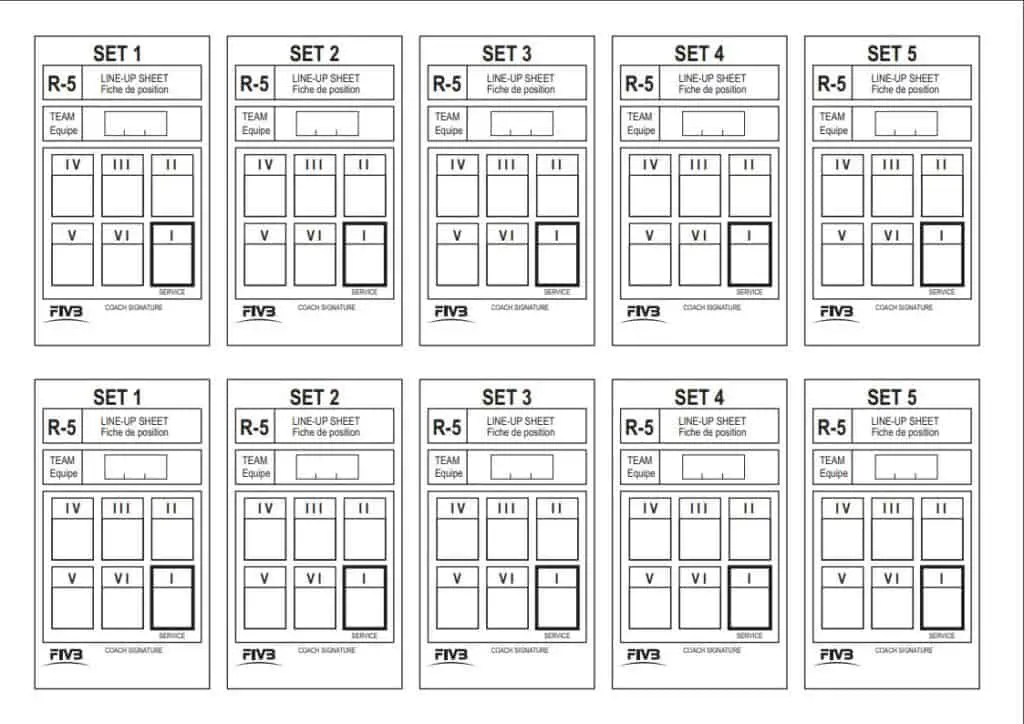Volleyball Lineup sheets although small and seemingly unimportant actually play a vital role in assisting the officials oversee a game.
Trying to remember things such as service order, rotations and lineups is challenging enough for the players let alone the officials who have to oversee two separate teams which could be running to completely different systems.
So just how do you fill out a Volleyball Lineup Sheet.
To fill out a volleyball lineup sheet you must do the following:
- Write the name of your team in the top box where it states Team:
- Identify which player is playing in position 1 (See below figure for position guide). Once you have determined which player is at position 1 note their jersey number in the box that states the roman numeral for 1.
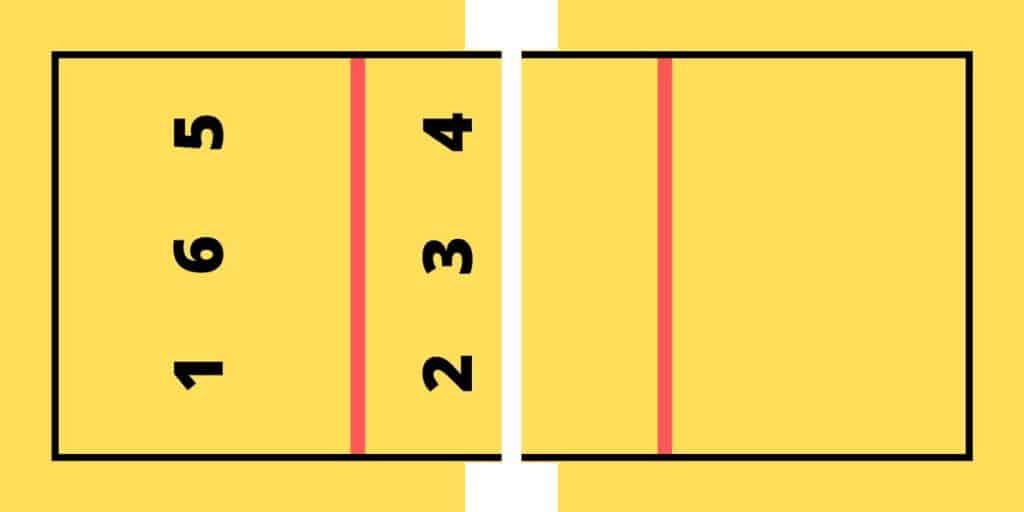
- Moving clockwise round the form, continue the above process until the lineup sheet is completed.
For a filled out example please see below figure.
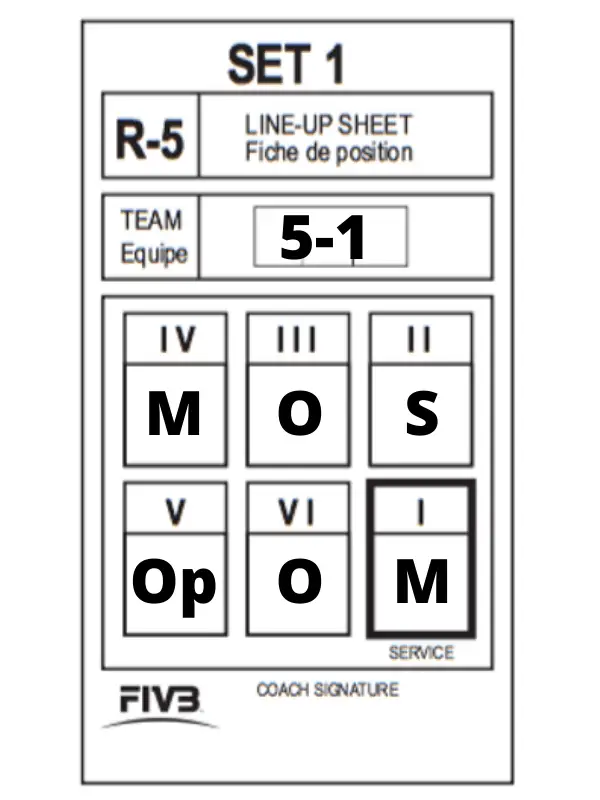
As you can see from the above, filling out a Lineup form is not complicated or difficult, however without knowing exactly what each section means it could lead to huge problems throughout the game.
Table of Contents
What Each Number Means
The first hurdle when filling out the volleyball lineup sheets is the numbers noted above each box.
The keen eye will notice that these are Roman numerals, the main reason Roman numerals are used is to make it clear when glancing at the sheet which numbers indicate zones/ positions on the court and also which numbers represent jersey numbers.
So just what do these roman numerals represent?
Well as touched on above the roman numerals indicate positions/ zones on the court.
The zones are as follows:
- Position/ Zone I (1) = Back right position on the court
- Position/ Zone VI (6) = Back Middle Position
- Position/ Zone V (5) = Back Left Position
- Position/ Zone IV (4) = Front Left Position
- Position/ Zone III (3) = Front Middle Position
- Position/ Zone II (2) = Front Right Position
For those who are more visual learners I have attached the below image with the zones noted.
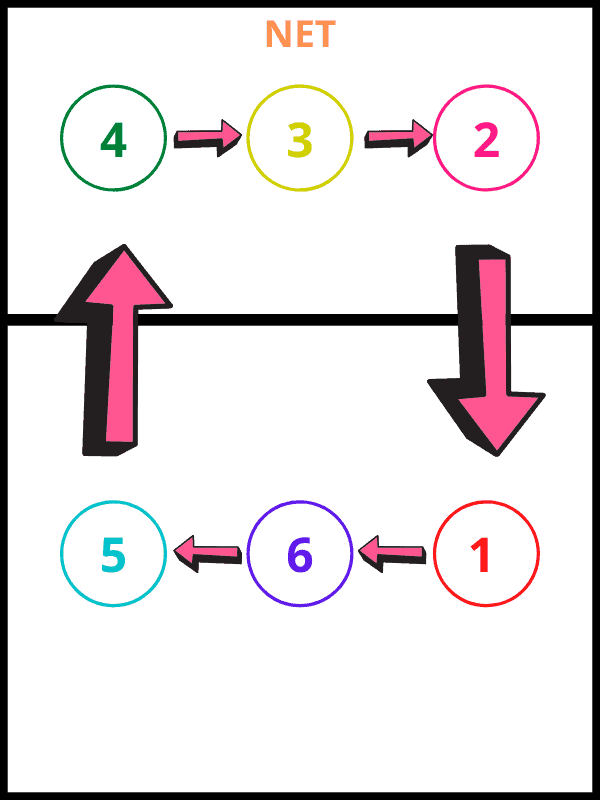
Some of you may be wondering why the numbers seem to go from position 1 to position 6.
Well the simple reason is the numbers on the lineup sheet indicates the service order.
For example position 1 means the player standing in this position will be serving 1st. The player in position 2 will be serving 2nd and so on.
When it comes to lineup sheets due to their simplicity there really isn’t anything further that could lead to any major issues.
Rules Relating to Lineups
You may be wondering why exactly we need to keep such a close eye on the lineup of our team?
Well the simple answer is because there are actually quite a few rules when it comes to the lineup of the team.
The main fault relating to lineups is a fault known as Illegal Alignment

This fault simply indicates that a team is not standing in the correct position or location on the court.
Now there are other rules relating to lineups however these aren’t as direct as the rotation error therefore I will touch on these further later in the article.
Basic Concept of Lineups
Although Volleyball Lineups look very structured and full of strict restrictions that actually isn’t much to them.
There aren’t lots of highly restrictive rules, but more one rule that has a heavy influence on the final lineup.
The main concept of creating a lineup sheet is that players in the same position must be opposite each other in the lineup.
For example if a team is using the most popular rotation known as a 5-1 then a team would consist of the following players.
- 2no. Outside Hitters (Wing hitter)
- 2no. Middle Hitter
- 1no. Setter
- 1no. Opposite (Right Side Hitter)
Using the above noted players a traditional lineup would look like the below image.
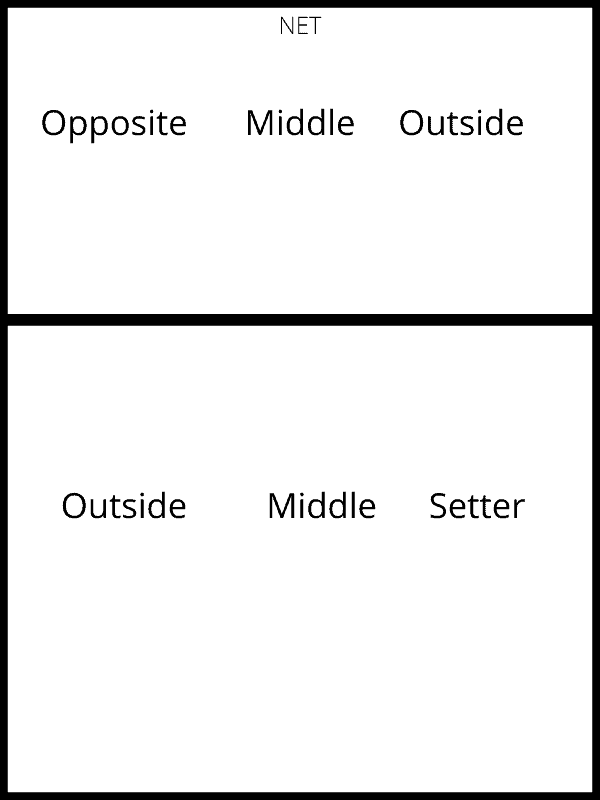
What is the Purpose of a Lineup Sheet
Hopefully after reading through the above you are starting to realise how such a small piece of paper can play such a vital role in the event.
If I had to pinpoint what the main purpose of the lineup sheet is then my summary would be as follows, to assist the officials to ensure they know the location and order of each player on both teams.
So just how exactly do the officials use these lineup sheets?
How Officials Use Lineup Sheets
So I have already covered the major way in which officials use lineup sheets to oversee the game and that was when looking for illegal alignments.
When discussing illegal alignments I hinted that there were additional rules/ faults that officials can use the lineup sheets to help identify.
The first fault is known as rotation errors.
Rotation Errors
Now I won’t bore you with everything you would need to know about rotations as I have other articles which cover this topic.
So if you need to know more about the rules of rotations then I suggest clicking here to be taken to the relevant article.
Now rotation errors and improper alignments are actually quite closely related and to be honest could be interchangeable with each other.
Improper alignment is normally used when players start in the positions.
Rotation errors are often used when players attempt to rotate too soon (meaning the ball has not crossed the net from the service).
By rotating too soon the players move into incorrect positions. This is known as a rotation fault.
Service Order
The next fault that Lineup sheets can and often are used to identify, is the wrong or incorrect server.
As noted above in the ‘What Do The Numbers Mean’ section I touched on the fact the numbers actually represent the service order.
For example the player at position 2 is 2nd in the service order.
Using lineup sheets can make identifying the correct or rather incorrect server much easier.
This allows officials to assist teams in ensuring the correct server steps up to serve.
This also means the opposite is true and officials are able to quickly recognise the fault and award the point to the receiving team.
Substitutions
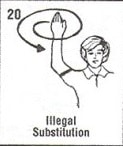
The last way in which a lineup sheet can be used to assist officials (Albeit infrequently) is when teams make substitutions.
Generally speaking in Volleyball when a player is substituted, the player who has been substituted can only return to the match if subbed back in for the player who originally replaced them.
Using the lineup sheet can make identifying which player has been removed extremely easy as the lineup sheet can be compared to the current lineup to identify which player was originally replaced.
In the interest of providing the correct information, you may be curious as to why I said generally speaking a player can only be subbed back in if replacing the player who originally replaced them.
Well that’s because there are some exceptions to this rule which I have touched on previously in other articles. Exceptions to the rule include things such as rotations concerning Liberos or rotations due to injuries.
Free Downloadable Lineup Sheets
So there you have it, everything you need to know about Lineup sheets and how to fill them out.
I hope you have found this article informative and useful.
As a final parting gift I want to offer a free downloadable sheet with lineup templates on that you can take with you and start using moving forward.
On each sheet you will find 5no. Templates so you can be sure that one sheet will see you through a full match even if it goes to 5 sets.
Simply click on the below image to start your download instantly.

